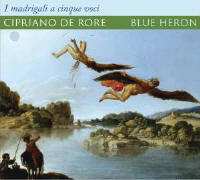Texte paru dans: / Appeared in: |
|
|
Reviewer: J.
F. Weber
My collection of seven full
discs of Cipriano de Rore (1515–1565) has a lot of sacred music and only a
few madrigals, notably Le Vergine (Fanfare 17:2; CD in 17:5), but I don’t
have the Fifth Book of Madrigals that the Consort of Musicke made well over
two decades ago. Just lately four new CDs devoted to the composer’s
madrigals have appeared to restore a balance (one of them has a new Le
Vergine), but this is the first of them to come for review. This book is the
first music that he published, reprinted nearly a dozen times through the
end of the century. Later books in the series were identified more clearly
as “Second Book for Five Voices” or “First Book for Four Voices.” Four years
later found the composer at the court of the duke of Ferrara. He later went
to Parma, then San Marco in Venice succeeding Willaert for only a year, and
back to Parma. The booklet contains a 13-page note on the music by Jessie Ann Owens, the musicologist who worked with Metcalfe to prepare the performance. It is followed by a 24-page note by Metcalfe on the performance style. Between them this extensive documentation covers the gamut of information that we need to understand how De Rore set Petrarch (for 12 of the 20 texts) and other poets to music. A novel feature of the recorded presentation is Alessandro Quarta’s recitation in rhetorical style of each poem before it is sung. On separate tracks that add a minute to the four to five minutes of most of the sung madrigals, they add immensely to our appreciation of the texts but can be skipped on repeated hearing if desired. These discs are focused as much on Renaissance poetry as on music. The singers have studied the texts to achieve a familiarity with the language. I tried to single out one or another madrigal for more emphatic praise, but they are uniformly entrancing. The opening and closing madrigals, however, are both by Giovanni Brevio, priest, poet, author, who lived in the Veneto. De Rore gave him pride of place for good reason. We have been waiting for this recording ever since Owens and Metcalfe were given the Noah Greenberg Award by the AMS in 2015 to produce it. I know of no other recording of a complete book since Rooley’s Fifth Book, so this is an outstanding success. These singers have established themselves in the first rank of vocal ensembles ever since their first recording on their own label, a cross-section of Guillaume Du Fay’s music (31:1) that displayed the same level of scholarship that has continued to be a part of their presentations. I called it “one of the finest Du Fay collections to come along in recent years.” De Rore deserves an equal accolade.
| |
|
|
|
|
|
|
|
Cliquez l'un ou l'autre
bouton pour découvrir bien d'autres critiques de CD |
|




